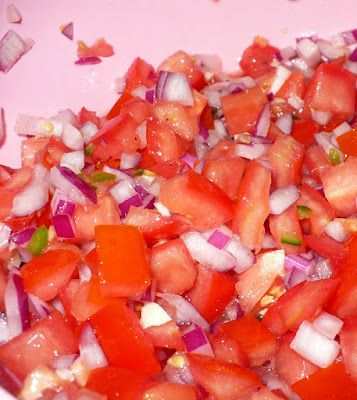 Despite the rather pedestrian appearance of the meal above, it represents an experiment--a test, of sorts--that I am conducting upon myself, your faithful writer. As a personal challenge, I have taken it upon myself to pick up one ingredient--be it vegetable, meat, marinade, or anything in between--each week that I have never worked with before and put something together using it to what will hopefully turn out to be a palatable dish. So far... well, the important part is trying. And although this week's dish may not look beautiful, it was still edible, and not a bad first attempt, as far as I'm concerned.
Despite the rather pedestrian appearance of the meal above, it represents an experiment--a test, of sorts--that I am conducting upon myself, your faithful writer. As a personal challenge, I have taken it upon myself to pick up one ingredient--be it vegetable, meat, marinade, or anything in between--each week that I have never worked with before and put something together using it to what will hopefully turn out to be a palatable dish. So far... well, the important part is trying. And although this week's dish may not look beautiful, it was still edible, and not a bad first attempt, as far as I'm concerned. As the title of this post may suggest, this week I picked up a bunch of rainbow chard, both because I'd been curious about it in the past and because colorful items rank just below shiny things on my list of personal distractions. Entering into this, I knew nothing about chard, regardless of its prismatic orientation, and determined to remedy the situation post-haste. Unfortunately, some quick internet research turned up a strange dearth of interesting chard-related recipes, none of which utilized anything I had on hand aside from the chard itself. Undaunted, I delved deeper into my pantry and decided that a bag of brown rice I had lying around would make a perfect side dish for the vegetable's finished product.
As the title of this post may suggest, this week I picked up a bunch of rainbow chard, both because I'd been curious about it in the past and because colorful items rank just below shiny things on my list of personal distractions. Entering into this, I knew nothing about chard, regardless of its prismatic orientation, and determined to remedy the situation post-haste. Unfortunately, some quick internet research turned up a strange dearth of interesting chard-related recipes, none of which utilized anything I had on hand aside from the chard itself. Undaunted, I delved deeper into my pantry and decided that a bag of brown rice I had lying around would make a perfect side dish for the vegetable's finished product.Having set the rice maker to "rice", I set off in search of protein. After a brief survey of my refrigerator's sparse contents, I emerged from the frosty wasteland with some leftover pork tenderloin and a bag of bean sprouts. I love bean sprouts, but they have the irritating tendency to spoil approximately 2 minutes after I pick them up off the shelf at the store; consequently, I had to use the damn things up before I had to throw yet another half-empty bag of them away. As for the pork... well, I needed protein, and pork tends to be fairly malleable when it comes to flavor. Ingredients in hand, I stared at them on the counter for a few minutes, mind a-whirling, in hopes of finding some inspiration. Given that I was hungry already, I decided a fast concoction would definitely be best. And what better fast-cooking method can there be than a stir-fry?
Stir-fried rainbow chard with pork tenderloin
(Well, it's not a real recipe, so I figured a descriptive title would be best)
Ingredients
1 Bunch rainbow chard, chopped
1 Leftover chunk of pork, sliced thin
1/2 Bag of bean sprouts
2tbsp Hoisin sauce
1tbsp Oyster sauce
1tbsp Soy sauce
Procedure
1) Heat 1 liter of water in a wok or large saucepan until it just reaches a boil.
2) Add the chopped chard and boil for 1 minute.
3) Remove the chard to a colander and allow to rest for a bit.

4) In the same pan, add the hoisin, oyster, and soy sauces and mix briefly. Add the pork and shake to coat.
5) Cook until the sauce has mostly disappeared.
6) Add the bean sprouts to scoop up the remaining sauce and shake to combine. Or stir. I prefer shaking, as it's more impressive and reduces cleanup.

7) Remove from heat and add the chard back into the mix. Shake or stir to combine the ingredients. Serve alongside the rice prepared previously.

Lessons Learned
Chard is bitter. As such, I think it can benefit from strong flavor combinations; this dish was somewhat weak, and the chard came through very strongly. It still tasted good, but I might consider a stronger sauce if I made it again. Otherwise, it was a satisfying spur-of-the-moment dish, so I can't really complain. I can only hope my future experiments work out so smoothly.












